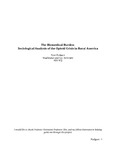| dc.rights.license | In Copyright | en_US |
| dc.creator | Hodgson, Ryan E. | |
| dc.date.accessioned | 2018-04-17T11:24:02Z | |
| dc.date.available | 2018-04-17T11:24:02Z | |
| dc.date.created | 2018 | |
| dc.identifier | WLURG38_Hodgson_POV_2018 | |
| dc.identifier.uri | http://hdl.handle.net/11021/33956 | |
| dc.description | Capstone; [FULL-TEXT FREELY AVAILABLE ONLINE] | en_US |
| dc.description | Ryan E. Hodgson is a member of the Class of 2018 of Washington and Lee University. | en_US |
| dc.description.abstract | The current opioid epidemic is a highly complex issue, and as such, claims of direct causation seem nearly impossible. Yet another challenge arises in attempting to determine which components of the overall epidemic more significantly impact rates of opioid addiction and overdose. This paper simply aims to introduce yet another perspective for consideration in the ongoing discussion surrounding the opioid crisis, as its death toll continues to rise. Analyzing the early introduction and promotion of opioids for chronic pain care illustrates the prevalence of the biomedical framework in our society – gaining success in its treatment of infectious disease, providing a platform for pharmaceuticals to promote opioids, and being further reinforced through our shifting expectations for pain care. Then placing rural health systems within this infrastructure, we see how rural providers inevitably rely more heavily on this biomedical model as the default solution in pain treatment, when burdened with decreased availability of alternative resources. With limited access, patients and providers in these rural areas are ultimately cornered into the norm of biomedical approaches to medicine – regardless of its ability or inability to adequately treat all types of ailments. [From final section] | en_US |
| dc.description.statementofresponsibility | Ryan Hodgson | |
| dc.format.extent | 32 pages | en_US |
| dc.language.iso | en_US | en_US |
| dc.rights | This material is made available for use in research, teaching, and private study, pursuant to U.S. Copyright law. The user assumes full responsibility for any use of the materials, including but not limited to, infringement of copyright and publication rights of reproduced materials. Any materials used should be fully credited with the source. | en_US |
| dc.rights.uri | http://rightsstatements.org/vocab/InC/1.0/ | en_US |
| dc.subject.other | Washington and Lee University -- Capstone in Shepherd Program for the Interdisciplinary Study of Poverty and Human Capability | en_US |
| dc.title | The Biomedical Burden: Sociological Analysis of the Opioid Crisis in Rural America | en_US |
| dc.type | Text | en_US |
| dcterms.isPartOf | RG38 - Student Papers | |
| dc.rights.holder | Hodgson, Ryan E. | |
| dc.subject.fast | Bioethics | en_US |
| dc.subject.fast | Opioid abuse | en_US |
| dc.subject.fast | Community health services | en_US |
| dc.subject.fast | Medicaid | en_US |
| dc.subject.fast | Rural poor | en_US |
| dc.subject.fast | United States | en_US |
| local.department | Shepherd Poverty Program | en_US |
| local.scholarshiptype | Capstone | en_US |
